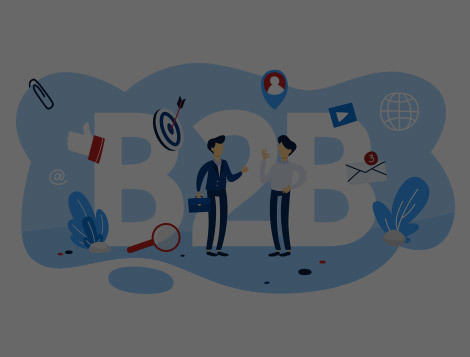Technology has seeped into a majority of marketing domains. And B2B or business-to-business marketing is no exception to this. For decades, B2B companies have followed techniques that are similar to customer or B2C marketing. But the time has come when they need to rethink their marketing strategies and make them more suitable for the businesses or organisations that they are catering to.
Today’s B2B buying scenario involves more people, more touchpoints and more stakeholder involvement than it did a few years ago. For marketers, it means understanding the buyer scenario that they’re selling into, especially if it involves multiple decision makers across several departments.
B2B buyers are more empowered and informed of what they require. The numerous stakeholders involved in the buying process have very specific demands to enhance their customer experience.
So, as a B2B company, you need to be prepared to accommodate all these aspects and implement a distinct assortment of marketing strategies that appeal to your B2B audience.
We have listed 6 proven ways that’ll help you build a strong B2B marketing strategy to stay ahead of your competitors.
1. Determine your brand positioning


Today, more than ever, businesses have a myriad of options to choose from. In order to stand out from other companies offering similar products or services and achieve a stronger brand recall, you need to have an effective brand positioning. Brand positioning defines your brand story, the narrative of who it actually is, who it targets, what problems it will solve, and how it will help other businesses. It’s the way in which your customers will perceive your brand. Hence, the first step is to have a strong brand positioning that will be a guiding principle for your team and customers.
A good way to position your brand is to identify its archetype. For instance, Salesforce defined its brand positioning with the archetype of ‘rebel’. When it launched in 2000, it held a mock demo in San Francisco with protestors holding placards that read “The End of Software”. This viral brand positioning caught the eyes of everyone in the tech industry.
Salesforce did what it promised. It revolutionised the CRM market with its disruptive and game-changing services. This particular example underscores the importance of positioning your brand uniquely to stand out in the market.
2. Identify your target audience


Once you have rightly positioned your brand, the next step is to identify and target the right audience. Marketing your services to a random audience will be a waste of effort. As opposed to that, finding your best-fit audience will help you build buyer personas and create relevant communications around them. Buyer personas will also give you an insight into the customer’s buying pattern to further understand their purchasing decisions and include that while devising an effective marketing strategy.
One of the best market examples of this strategy is what Unacademy did. During its brand awareness campaign, Unacademy accurately identified their target audience based on their age group. Keeping this approach in mind along with the insights from past campaign executions, Unacademy adopted a multi-channel approach.
It focused its brand awareness campaign on the platforms like Jio, Gaana.com, InShorts, Dailyhunt, etc. where their ideal target audience was most active. The campaign outcome was 9.5 million impressions and a 25% increase in website traffic.
3. Run a competitive analysis


Merely identifying your target audience isn’t enough. You need to go a step further and find out how your competitors are marketing their products and services to your target audience. You also need to understand how their communication is and if they are using any specific tactics or strategies to reach their audience. Competitive analysis is the best way to identify the strengths, weaknesses, opportunities, and threats for your brand. While carrying out competitive analysis, you need to pay close attention to their:
- Products or services
- Marketing tactics and success rate
- Content and social media reputation
4. Explore marketing channels to use


After successfully carrying out the competitive analysis, you will also learn the marketing channels that are most effective and relevant for your offerings. You can consider emphasising these channels and reaching your target audience more effectively. Furthermore, every marketing channel has a distinct format and style that works the best. So, once you have the appropriate marketing channel in place, you can customise your communication and design content accordingly.
5. Marketing Automation with CRM & Lead Nurturing


As the name suggests, marketing automation automates all the repetitive and manual marketing activities with valid technological solutions. It’s an effective way to create, manage, and track your campaigns and their performance. Marketing automation reduces manual work, thereby giving your team more time to focus on creating a compelling marketing strategy and nurturing the leads that can actually convert.
Through automation, you can also get a deeper insight into the buying patterns and preferences of your potential customers. Two of the most effective aspects of marketing automation are CRM and lead generation.
CRM, i.e. Customer Relationship Management Software, is a centralised software that provides you with a more comprehensive view of your customer data by storing it in an easily accessible database. This helps your company in forming better customer relationships and nurturing them over time.
The customer database contains information like contact details, purchases and conversation history, requests, complaints, etc. This information leads to a more seamless and personalised customer interaction. CRM is more dependable as it can track historical data across all your teams, thereby equipping you with the right data to boost conversions. CRM further helps you to:
- Find and target the right leads
- Curate hyper-personalised campaigns
Another important aspect of automation is lead nurturing. It is a process through which you can develop and maintain strong relationships with your customers at every stage of the marketing funnel. An effective lead nurturing program has customer communication at its centre. It works towards providing all the necessary information to the potential customer, answering their questions, reassuring them with exciting offers, and maintaining this relationship until they get converted.
Automation helps your teams to curate more personalised offers and communications to aid your lead nurturing program. That way, you engage potential customers throughout their buying journey. Automation not only helps your lead nurturing program but also helps in boosting your click-through rates (CTRs) and the customer’s inclination to buy.

Interesting:
Along with personalised communication, a lead nurturing program also helps you to use the available data to monitor the customer’s buying patterns, understand their preferences and optimise your campaigns and communication accordingly. All these aspects will contribute to increasing your ROI and profits.
One of the best examples of marketing automation with CRM is Cisco’s approach to increase its team productivity and boost its sales opportunities. The company introduced a WebEx program to streamline processes. This program was used to address complex issues by customers and to contact a trained rapid response team.
After this implementation, salespeople were able to spend 20% more time on strategic and productive tasks. They also increased their external interactions by 40%. All these objectives were achieved while cutting travel related expenses by 40%-60% over three quarters. This is how CRM can improve employee productivity.
6. Have a niche-driven approach


Another important aspect to consider while devising a marketing strategy is to have a niche-driven approach. Identifying the niche targeting area and gaining its end-to-end understanding can definitely lead to success.
Niche targeting works the best as it helps you channelise your marketing effort in a more specialised and well-defined manner. It helps you in clearly defining your offerings and delivering them effectively. This further helps in distinguishing yourself from your competitors. Hence, having a niche-driven approach can be extremely beneficial while formulating a winning B2B marketing strategy.
In conclusion
Following all these steps will surely help you build a full-proof B2B marketing strategy. And you can experience a more targeted and growth-driven approach with Amura Marketing Technologies, a leading B2B digital marketing agency in India.
Amura, through its full-funnel marketing and MarTech expertise, can add value to your overall B2B marketing strategy and help you reach your target audience more effectively. So, are you ready to rethink your B2B marketing strategy with Amura? Get in touch with us today!

